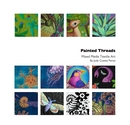One fun little technique I found works great with acrylic inks (this would also work with Tsukineko inks) is to draw on fabric with a colored pencil or china marker and paint over it like a simple resist. Kind of like in grammar school when you colored with crayons and painted india ink over the top.
So why pencil versus china marker? Simply, pencil will give you a thinner defined line and the china marker a thicker heavier line.
In this case brand does matter. The first sample, if you can see it, was written with a Blick store brand white colored pencil and the second was a Berol Prismacolor white pencil. The Blick pencil was not as creamy and waxy and did not create a very good resist, the ink painted right over it.
If you are unfamiliar with china markers, they are a pencil that can write on a non-porous surface, like plastic, glass or metal and then can be wiped of with a firm rub with a dry cloth.
You don't sharpen them, instead you peel back the paper wrap covering by grasping that little string and pulling it back to the first perforated row
grab the paper, unwind it
then draw.
This is a sample I worked on in the acrylic inks class, layering up multiple different techniques.
The thick white lines are textile paint, the thinner flower vine pattern in the center of the paisley is china marker.
The little pale blue crosses in the background were also drawn with white china marker and then painted over with blue ink. I like how they show up really well and have a hint of blue.
I painted over the center of the paisley with red ink.
The pencil does not penetrate the fibers like a gutta resist, so if you have a lot of ink on your brush and the fabric gets really wet it will bleed beyond the pencil lines, but the white lines of the drawn imagery will show through, which to me is the effect I really like.
I painted inside the flowers and leaves with red-violet ink to make them stand out more. The benefit of the china marker was that I could quickly add color without being too fussy and neat because it kept the ink fairly contained.
Voila!












































Great idea, thanks for sharing.
ReplyDeleteHow does it wash? I'm thinking skirt/shirt designs would be cool. Probably on muslin?
ReplyDeleteAcrylic inks are water resistant, not waterproof, so they are better for art projects that will not be washed as opposed to wearables. You could try using this technique with transparent base textile paints, as long as the paint isn't too thick it should probably work.
Delete